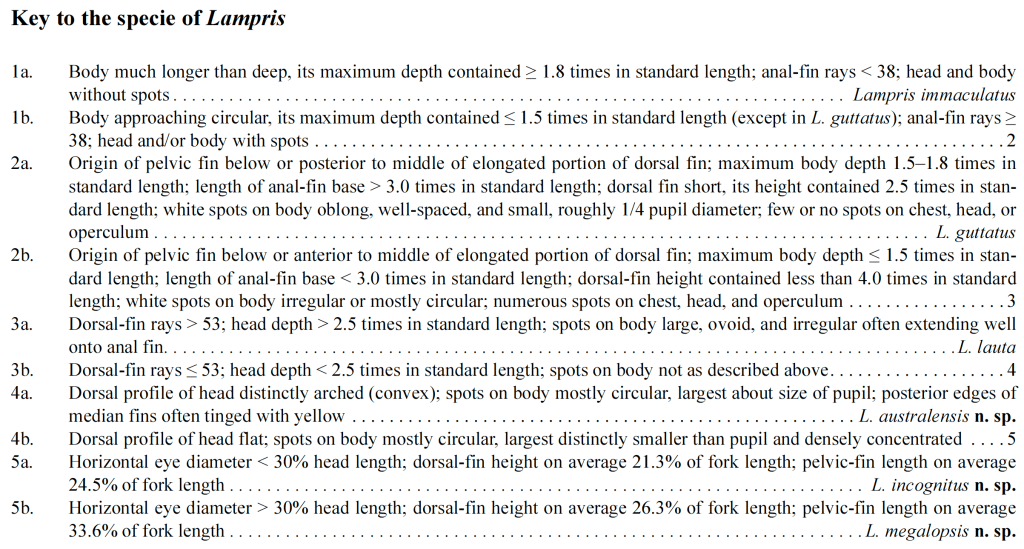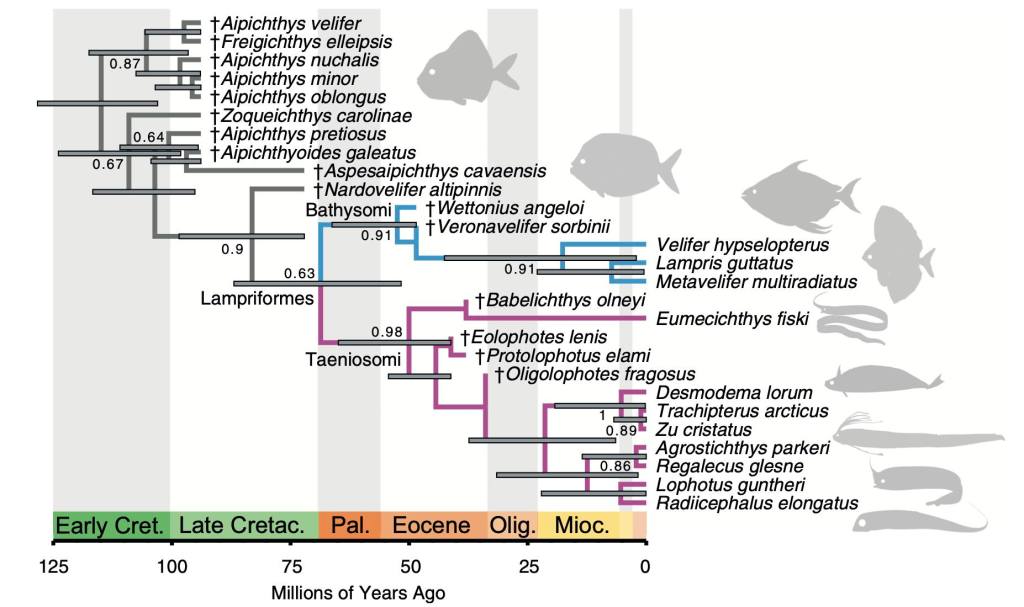The #SundayFishSketch is an X (previously Twitter) hashtag that encourages like-minded individuals to incorporate art and fish into their weekly lives. It is a great community to join for new/aspiring artists and is also a way for more seasoned artists to practice. Many of the #SundayFishSketch themes can be fun getaways to focus on away from your current life while others touch on relevant and current holidays or world topics. This time I briefly recap the hashtag’s humble beginnings and focus on the first ever #SundayFishSketch illustrated fish, the Opah (Lampris guttatus).
#RECAP
If you haven’t already checked out our previous blogs posts on the #SundayFishSketch and are interested in learning about its history, please do so. The first post, written by one of our other authors Hank Hershey highlighted the beginnings of the #SundayFishSketch hashtag. The second post highlights the hashtag’s growth through the years and different community member thoughts. Both blog posts do a fantastic job covering the the background, development, and community of the hashtag.
#LAMPRIS
Every year on the weekend closest to October 23rd, the #SundayFishSketch celebrates its birthday. In 2016, the first fish that was posted was the Opah (Lampris guttatus), and today I highlight how interesting this fish is and how our perception of this species (now multiple species) has changed in the 7 years since the hashtag started.
Lampris, meaning “brilliant/clear” in greek, and gutattus meaning “spotted” in latin, is the perfect beginning to the description of this fish.
The opah, or moonfish, are relatively large fish with silver and red/orange coloration and white spots. They are found worldwide in pelagic marine habitats and feed on squid, smaller fish, and large quantities of krill. They are not generally fished for, but are often caught as bycatch. They are usually solitary and swim at relatively slow speeds, using their robust pectoral fins to move through the water.
Opahs are part of an increasing number of fish species found to be able to warm their bodies above the ambient temperatures around them. Other fish species that can achieve a similar effect where they only warm certain parts of their body (regional endothermy) include tuna and lamnid sharks. Unlike these fishes, the opah can warm its entire body (whole-body endothermy) about 5°C higher than the temperature of the surrounding water. This adaptation is believed to aid in moving faster while in deep, cold waters in search of prey.
Until recently, scientists traditionally recognized 2 species of opahs (genus Lampris), L. immaculatus and L. guttatus. L. immaculatus was the smaller Southern Ocean species, usually only reaching about 3-4 ft in length. L. guttatus was the more widespread and larger species, reaching 6-7 ft in length. In 2018 after a taxonomic review, Underkoffler et al. suggested different populations of Lampris guttatus should be split into several species with more limited ranges. These scientists based this suggestion on the results from a combination of molecular and morphological data. Below I outline each of the current suggested opah species.
Lampris australensis (Southern spotted opah) – can be found in the Southern hemisphere, in the Pacific and Indian oceans.

Lampris guttatus (North Atlantic opah) – formerly thought to be widely distributed, this species is now restricted to the northeastern Atlantic and the Mediterranean Sea.

Lampris immaculatus (southern opah) – only found in the Southern Ocean from 34°S to the Antarctic Polar Front.

Lampris incognitus (smalleye Pacific opah) – can be found in central and eastern North Pacific Ocean.

Lampris lauta (East Atlantic opah) – located in the eastern Atlantic Ocean, the Mediterranean, and the Azores and Canary Islands.

Lampris megalopsis (bigeye Pacific opah) – a cosmopolitan species that can also be found in the Gulf of Mexico, Indian Ocean, the western Pacific Ocean, and Chile.


Pictures and Key provided above were pulled from the Underkoffler et al. (2018) study.
#LAMPRIFORMES
Opahs are within the order Lampriformes, a closely related lineage of fishes that all reside in the open ocean. Although most of the members of this order have bright red fins and/or silvery bodies, similar to species of Lampris, most of the other 20+ members of this group have longer, more ribbon-like bodies. The Lampriformes also includes the well-known giant oarfish (Regalecus glesne), the worlds longest ray-finned fish.

A recent study by Brownstein and Near (2023) assessing the phylogenetic relationships of the Lampriformes and the evolution of their body shapes suggests that all of the ribbon-like taeniosome species, like the oarfish and the ribbonfishes, are more closely related to each other than the round-bodied bathysome species, like the opah and the sailfin moonfishes. This result indicates that longer bodies only evolved once in the common ancestor of the Taeniosomi and not multiple times within the Lampriformes.

Whether or not you follow the #SundayFishSketch or are just a fan of opahs, check back next month for more fish-related art!
ARTIST OF THE MONTH
What is it like to participate in the #SundayFishSketch? Just ask our artist of the month, Mitch Smith (@CreativeMitch), artist, communicator, and mental health expert.
How long have you been participating in the #SundayFishSketch?
My first post was on my birthday back in July of 2020 and it was a black pencil drawing of a Yellow Bullhead (Ameiurus natalis), a favorite nighttime quarry of mine as a kid fishing the river (the Looking Glass River in Michigan) my childhood home sat on the banks of.
“Yellow Bullheads (Ameiurus natalis) are voracious scavengers that will eat just about anything, live or dead, that they get their jaws around. They have venom in their dorsal and pectoral spines, and envenomation from their menacing sting can be painful. Black pencil sketch. #SundayFishSketch” –

Why did you decide to participate and has it been difficult to sketch on a semi-regular basis?
It has been kind of a strange journey to get to my reasons for participating in the #SundayFishSketch fish sketch. I made my living for many years as an Art Director for a monthly magazine and then switched over to working in the fields of communication, member relations, and ultimately as a mental health therapist. As I’ve changed and grown over time, I have come to understand the importance of the functions of neuroplasticity in the human brain. I learned that neuroplasticity of the human brain, when mixed with art engagement, such as in a daily practice of the art of drawing, painting, music, or other artistic expressions, can be incredibly beneficial for maintaining cognitive functions and mental wellbeing. I decided to try a personal experiment of doing a drawing a day for a year starting in 2018, to improve my art skills as well as to work on keeping my brain flexible and as healthy as possible.
This “experiment” led me to finding a way to be accountable for daily creation of art so I created Facebook, Twitter, and Pinterest pages to post my art. My curiosity pushed me to enhance the art by also discovering interesting nature facts about the creatures that inhabit the planet that I would be sketching, drawing, and painting. I needed to look for inspiration which led me to explore drawing related hashtags such as #Inktober where I found the #SundayFishSketch prompt in another artist’s post.
Do you believe your art has improved since joining the hashtag?
The #SundayFishSketch has allowed me to expand my creativity, improve my art abilities, expand my knowledge of the world through exploring all the other scientists, artists, and other fish enthusiasts who post on the hashtag, as well as support my own mental wellbeing. Also it has allowed me to try different media such as watercolor, pen & ink, pencil and other mixed media. I’ve also been able to connect to people around the world and have actually sent some of my drawings to people in Canada and as far away as Australia.
What has been your favorite theme thus far and why?
My favorite themes so far has been the ones surrounding the Super Bowl because they have allowed me to be playful, fanciful, and creative in my drawing. However, any time a #FishyTheme can be connected to a member of the catfish family, I get pretty darn excited to break out the art supplies.

Check out Mitch’s Facebook for additional fantastic (although often non-fish related) art. These are absolutely worth exploring.
START SKETCHING
Interested in participating in the #SundayFishSketch? Join us by posting your fish art on Twitter using the hashtag! Are you are interested in learning how to draw fishes but are unsure of where to start? Check out my previous post on ‘How to draw a fish’ as a place to begin. We look forward to seeing your fishy creations!

Wow nice information… thx